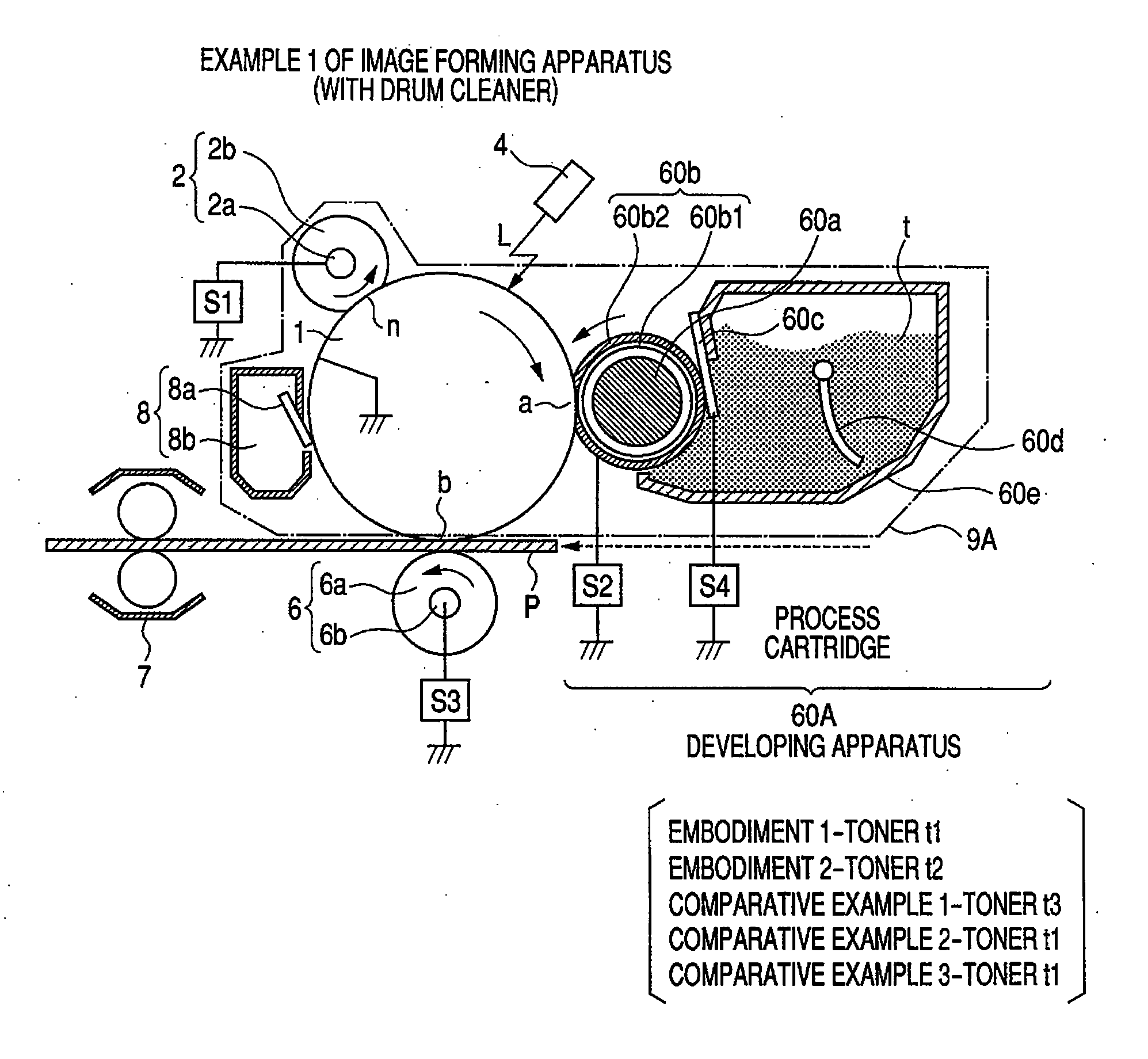Developing apparatus
a technology of developing apparatus and developing chamber, which is applied in the direction of electrographic process apparatus, instruments, optics, etc., can solve the problems of difficult compatibility with ghost image fault, reduced fog performance, and inability to remove toner, so as to prevent fog, improve the uniformity of thin lines, and prevent uneven density
- Summary
- Abstract
- Description
- Claims
- Application Information
AI Technical Summary
Benefits of technology
Problems solved by technology
Method used
Image
Examples
embodiment 2
[0082] A developing apparatus according to this embodiment basically conforms to the developing apparatus 60A described in Embodiment 1, but used a toner t2 as the developer, as shown below.
[0083] Toner t2: The mono-component magnetic toner t2 which is the developer was made via the steps of mixing, kneading and crushing a binding resin, magnetic material particles and a charge controlling agent, and improving the surface quality thereof and classifying them, and adding a fluidizing agent or the like as an extraneous agent (a crushing method, see for example, Japanese Patent Application Laid-open No. 2002-341590). The magnetic material particles were prescribed by the same weight as the binding resin to thereby make magnetic particles which are conveyable by a sufficient magnetic force. Also, the mean particle diameter (D4) of the toner was 6 μm, and the mean degree of circularity found by the above-described method was 0.968.
example 1
(Example 1 of the Image Forming Apparatus)
[0229] At first, comparison is made about Example 1 of the image forming apparatus (with a drum cleaner).
(1-6a) Comparison with Comparative Examples 4 and 5
[0230] Comparison will first be made with Comparative Examples 4 and 5 in which the blade bias is not applied.
[0231] In Comparative Example 4, in contrast with Embodiment 1, the blade bias is not applied. In a case where the blade bias is not applied, under a high-temperature and high-humidity environment, fog is initially slight, but is aggravated as the number of printed sheets is increased. This is because a proper toner layer thickness and proper charge imparting were not provided by the regulating blade 60c. That is, the abutting position of the regulating portion was made into a pole position, whereby relative to the toner conveying amount by the regulating portion, a toner amount capable of being subjected to proper charge imparting was exceeded. Further, because of the regulat...
example 2
(Example 2 of the Image Forming Apparatus)
[0270] Comparison will now be made about Example 2 of the image forming apparatus (Cleaner-less System).
(1-7a) Cleaner-less Collecting Property and Solid Black Image Fault
[0271] About the toner collecting property in the cleaner-less system, Comparative Examples 6, 7 and 8 which are of the non-contact developing type were bad in the collecting property, while on the other hand, Embodiments 1 and 2 and Comparative Examples 1 to 5 and 10 to 12 were good because of the contact development. However, in Comparative Example 9 which is of the contact developing type, although slightly, a reduction in the collecting property was somewhat seen. It is also conceivable to use a multi-pole magnet roll to improve the supplying and stripping-off property by a rotating magnetic force, but the magnetic force vibrates in the regulating portion and the developing portion and therefore, the toner layer is unstable and thus, the collecting property is consid...
PUM
 Login to View More
Login to View More Abstract
Description
Claims
Application Information
 Login to View More
Login to View More - R&D
- Intellectual Property
- Life Sciences
- Materials
- Tech Scout
- Unparalleled Data Quality
- Higher Quality Content
- 60% Fewer Hallucinations
Browse by: Latest US Patents, China's latest patents, Technical Efficacy Thesaurus, Application Domain, Technology Topic, Popular Technical Reports.
© 2025 PatSnap. All rights reserved.Legal|Privacy policy|Modern Slavery Act Transparency Statement|Sitemap|About US| Contact US: help@patsnap.com



